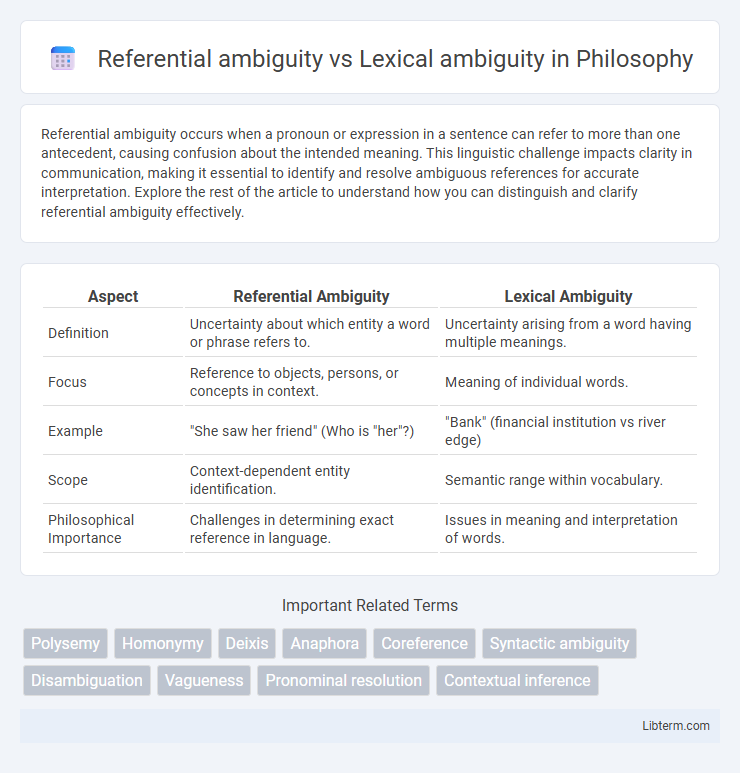Referential ambiguity occurs when a pronoun or expression in a sentence can refer to more than one antecedent, causing confusion about the intended meaning. This linguistic challenge impacts clarity in communication, making it essential to identify and resolve ambiguous references for accurate interpretation. Explore the rest of the article to understand how you can distinguish and clarify referential ambiguity effectively.
Table of Comparison
| Aspect | Referential Ambiguity | Lexical Ambiguity |
|---|---|---|
| Definition | Uncertainty about which entity a word or phrase refers to. | Uncertainty arising from a word having multiple meanings. |
| Focus | Reference to objects, persons, or concepts in context. | Meaning of individual words. |
| Example | "She saw her friend" (Who is "her"?) | "Bank" (financial institution vs river edge) |
| Scope | Context-dependent entity identification. | Semantic range within vocabulary. |
| Philosophical Importance | Challenges in determining exact reference in language. | Issues in meaning and interpretation of words. |
Introduction to Ambiguity in Language
Referential ambiguity arises when a pronoun or noun phrase can refer to multiple entities within a context, causing confusion about the intended referent. Lexical ambiguity occurs when a single word possesses multiple meanings, making interpretation dependent on the surrounding linguistic environment. Understanding these types of ambiguity is crucial in natural language processing and linguistics to resolve meaning accurately in communication.
Defining Referential Ambiguity
Referential ambiguity occurs when a pronoun or noun phrase can refer to more than one entity within a given context, causing confusion in identifying the intended referent. Lexical ambiguity, in contrast, arises from a word or phrase having multiple meanings, which can lead to different interpretations depending on usage. Understanding referential ambiguity is crucial for natural language processing and discourse analysis to accurately resolve pronoun references and avoid misinterpretation.
Exploring Lexical Ambiguity
Lexical ambiguity arises when a single word possesses multiple meanings, leading to varied interpretations based on context. This ambiguity complicates natural language processing by requiring algorithms to accurately discern word senses in sentences. Exploring lexical ambiguity involves analyzing homonyms and polysemes, leveraging contextual clues and semantic networks to enhance disambiguation accuracy in computational linguistics.
Key Differences Between Referential and Lexical Ambiguity
Referential ambiguity occurs when a pronoun or noun phrase can refer to multiple possible antecedents within a sentence, causing confusion about the intended subject. Lexical ambiguity arises when a single word has multiple meanings, leading to uncertainty regarding which sense is intended in context. The key difference lies in referential ambiguity being concerned with unclear relationships between expressions, while lexical ambiguity involves ambiguous word meanings.
Linguistic Examples of Referential Ambiguity
Referential ambiguity occurs when a pronoun or noun phrase can refer to multiple entities within a sentence, making the intended antecedent unclear. For example, in the sentence "John told Michael that he was late," the pronoun "he" could refer to either John or Michael, creating ambiguity. Unlike lexical ambiguity, which arises from a single word having multiple meanings, referential ambiguity depends on the context of pronouns or noun phrases and their possible antecedents in discourse.
Linguistic Examples of Lexical Ambiguity
Lexical ambiguity arises when a word or phrase has multiple meanings, leading to interpretative uncertainty in a sentence, such as the word "bank," which can mean the side of a river or a financial institution. Examples include homonyms like "bat" (an animal or a sports equipment) and polysemes like "light" (not heavy or illumination). Referential ambiguity, by contrast, occurs when a pronoun or a referring expression has unclear antecedents, creating confusion about which entity is being referenced.
Impact of Ambiguity on Communication
Referential ambiguity arises when a pronoun or noun phrase can refer to multiple entities, causing confusion in interpreting the intended subject, while lexical ambiguity occurs when a word or phrase has multiple meanings, leading to misunderstandings in message decoding. Both types of ambiguity hinder effective communication by causing misinterpretations and requiring additional cognitive effort to discern the speaker's or writer's true intent. In contexts like legal documents or technical instructions, referential and lexical ambiguities can significantly impact clarity, accuracy, and overall comprehension.
Ambiguity in Natural Language Processing
Referential ambiguity occurs when a pronoun or noun phrase can refer to multiple entities, complicating entity recognition and coreference resolution in Natural Language Processing (NLP). Lexical ambiguity arises when a word has multiple meanings, challenging word sense disambiguation algorithms to select the correct interpretation based on context. Effective handling of both referential and lexical ambiguity enhances the accuracy of language understanding models and improves tasks like machine translation, sentiment analysis, and question answering.
Strategies for Resolving Linguistic Ambiguity
Referential ambiguity occurs when a pronoun or expression can refer to multiple antecedents, while lexical ambiguity arises from a word having multiple meanings. Strategies for resolving these ambiguities include context analysis, syntactic parsing, and pragmatic inference to determine the intended referent or meaning accurately. Machine learning models incorporate large datasets and semantic networks such as WordNet to enhance disambiguation performance in natural language processing tasks.
Conclusion: Importance of Understanding Ambiguity in Language
Understanding referential ambiguity, where a pronoun or phrase can refer to multiple entities, and lexical ambiguity, where a word has multiple meanings, is crucial for effective communication and natural language processing. Misinterpretations arising from these ambiguities can lead to errors in information retrieval, machine translation, and human conversation. Enhancing disambiguation techniques improves clarity, reduces misunderstandings, and supports more accurate language comprehension in both humans and AI systems.
Referential ambiguity Infographic

 libterm.com
libterm.com